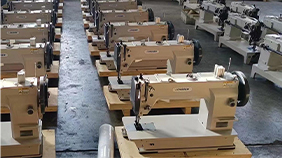sewing leather on domestic machine
Sewing Leather on a Domestic Machine A Guide for Beginners
Sewing leather can seem daunting, especially when using a domestic sewing machine. However, with the right techniques and tools, it can be a rewarding experience. This article will guide you through the essentials of sewing leather at home, ensuring that you achieve beautiful and professional-looking results.
Understanding Leather Types
Before starting your project, it’s essential to understand the different types of leather. Full-grain leather is the most durable and retains the natural texture of the hide, while top-grain leather is slightly processed and more pliable. Suede and nubuck are softer and have a different texture, making them easier to work with for beginners. For those just starting, consider using medium-weight leather, which is more forgiving and manageable.
Tools You Will Need
1. Sewing Machine Ensure your domestic sewing machine can handle thick materials. Check the manufacturer’s guidelines; some models might require modifications. 2. Leather Needle Use a specialized leather needle, which has a wedge-shaped point designed to penetrate leather without tearing it. This needle is crucial for clean stitches.
3. Thread Opt for polyester or nylon thread, as these are stronger and more suitable for leather projects than cotton thread.
4. Cutting Tools A rotary cutter or a sharp pair of scissors is ideal for cutting leather accurately. A cutting mat can protect your surfaces and improve cutting efficiency.
5. Walking Foot If possible, use a walking foot attachment to help move the leather through the machine evenly, preventing slippage.
6. Templates and Patterns Prepare your design beforehand. Paper templates will aid in cutting your leather pieces accurately.
sewing leather on domestic machine

Preparing to Sew
Before you start sewing, take the time to plan your project. Cut your leather pieces according to your template, and remember that leather doesn’t fray, which allows for raw edges if desired. However, you may want to finish edges with edge tools or leather cement for a polished look.
Sewing Techniques
1. Test Sew Always try sewing on a scrap piece of leather first. This helps you adjust your settings, such as stitch length and tension, ensuring a smooth operation during your actual project.
2. Stitch Length Use a longer stitch length (around 3-4 mm) for leather, as tighter stitches can weaken the material.
3. Sew Slowly Take your time when sewing. Leather can be difficult to maneuver, so slow and steady will yield better results.
4. Securing Edges Use clips instead of pins to hold pieces together, as pins can leave holes in the leather.
5. Finishing Touches After sewing, you may want to burnish the edges using an edge tool or a simple burnishing technique with a smooth tool to achieve a refined finish.
Conclusion
Sewing leather on a domestic machine is a skill that can be developed with practice and patience. By using the right tools and techniques, you can create beautiful leather projects that are not only functional but also stylish. Start with simple designs, gradually increasing complexity as your confidence grows. Happy sewing!
-
Industrial Cylinder Arm Sewing Machine: Revolutionizing Heavy-Duty SewingNewsJul.28,2025
-
Cylinder Arm Sewing Machine: Perfect for Special Sewing ApplicationsNewsJul.28,2025
-
Cylinder Bed Sewing Machine: Essential for Sewing Complex MaterialsNewsJul.28,2025
-
Heavy Duty Sewing Machine: The Essential Tool for Industrial ApplicationsNewsJul.28,2025
-
Computerized Pattern Sewing Machine: Revolutionizing Precision StitchingNewsJul.28,2025
-
Heavy Duty Industrial Sewing Machine: Power Meets PrecisionNewsJul.28,2025
-
Leather Sewing Machine: The Industrial Standard for Tough MaterialsNewsJul.18,2025





























